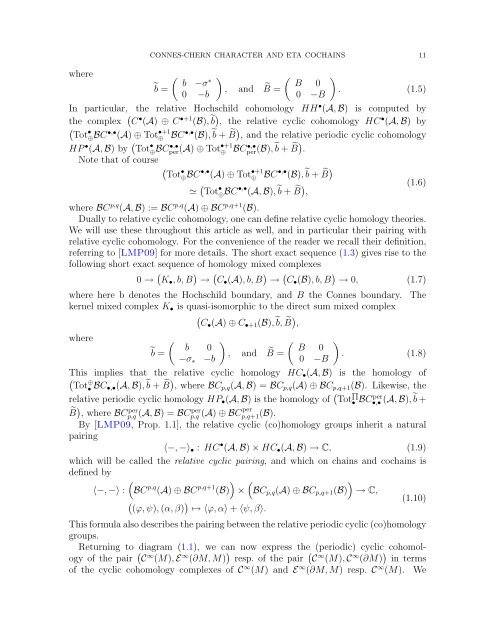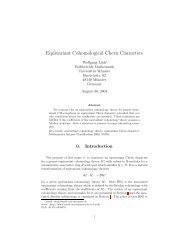Connes-Chern Character for Manifolds with Boundary and ETA ...
Connes-Chern Character for Manifolds with Boundary and ETA ...
Connes-Chern Character for Manifolds with Boundary and ETA ...
Create successful ePaper yourself
Turn your PDF publications into a flip-book with our unique Google optimized e-Paper software.
where<br />
CONNES-CHERN CHARACTER AND <strong>ETA</strong> COCHAINS 11<br />
(<br />
b −σ<br />
∗<br />
˜b =<br />
0 −b<br />
)<br />
, <strong>and</strong> ˜B =<br />
(<br />
B 0<br />
0 −B<br />
)<br />
. (1.5)<br />
In particular, the relative Hochschild cohomology HH • (A, B) is computed by<br />
the complex ( C • (A) ⊕ C •+1 (B),˜b ) , the relative cyclic cohomology HC • (A, B) by<br />
(<br />
Tot<br />
•<br />
⊕ BC •,• (A) ⊕ Tot •+1<br />
⊕ BC •,• (B),˜b + ˜B ) , <strong>and</strong> the relative periodic cyclic cohomology<br />
HP • (A, B) by ( Tot • ⊕BC per(A) •,• ⊕ Tot •+1<br />
⊕ BC per(B),˜b •,• + ˜B ) .<br />
Note that of course (Tot<br />
•<br />
⊕ BC •,• (A) ⊕ Tot •+1<br />
⊕ BC •,• (B),˜b + ˜B )<br />
≃ ( Tot • ⊕BC •,• (A, B),˜b + ˜B ) (1.6)<br />
,<br />
where BC p,q (A, B) := BC p,q (A) ⊕ BC p,q+1 (B).<br />
Dually to relative cyclic cohomology, one can define relative cyclic homology theories.<br />
We will use these throughout this article as well, <strong>and</strong> in particular their pairing <strong>with</strong><br />
relative cyclic cohomology. For the convenience of the reader we recall their definition,<br />
referring to [LMP09] <strong>for</strong> more details. The short exact sequence (1.3) gives rise to the<br />
following short exact sequence of homology mixed complexes<br />
0 → ( K • , b, B ) → ( C • (A), b, B ) → ( C • (B), b, B ) → 0, (1.7)<br />
where here b denotes the Hochschild boundary, <strong>and</strong> B the <strong>Connes</strong> boundary.<br />
kernel mixed complex K • is quasi-isomorphic to the direct sum mixed complex<br />
(<br />
C• (A) ⊕ C •+1 (B),˜b, ˜B ) ,<br />
where<br />
(<br />
b 0<br />
˜b =<br />
−σ ∗ −b<br />
)<br />
, <strong>and</strong> ˜B =<br />
(<br />
B 0<br />
0 −B<br />
The<br />
)<br />
. (1.8)<br />
This implies that the relative cyclic homology HC • (A, B) is the homology of<br />
(<br />
Tot<br />
⊕<br />
• BC •,• (A, B),˜b + ˜B ) , where BC p,q (A, B) = BC p,q (A) ⊕ BC p,q+1 (B). Likewise, the<br />
relative periodic cyclic homology HP • (A, B) is the homology of ( Tot Q • BC•,• per (A, B),˜b +<br />
˜B ) , where BCp,q per (A, B) = BCp,q per (A) ⊕ BCp,q+1(B).<br />
per<br />
By [LMP09, Prop. 1.1], the relative cyclic (co)homology groups inherit a natural<br />
pairing<br />
〈−, −〉 • : HC • (A, B) × HC • (A, B) → C, (1.9)<br />
which will be called the relative cyclic pairing, <strong>and</strong> which on chains <strong>and</strong> cochains is<br />
defined by<br />
(<br />
) (<br />
)<br />
〈−, −〉 : BC p,q (A) ⊕ BC p,q+1 (B) × BC p,q (A) ⊕ BC p,q+1 (B) → C,<br />
( ) (1.10)<br />
(ϕ, ψ), (α, β) ↦→ 〈ϕ, α〉 + 〈ψ, β〉.<br />
This <strong>for</strong>mula also describes the pairing between the relative periodic cyclic (co)homology<br />
groups.<br />
Returning to diagram (1.1), we can now express the (periodic) cyclic cohomology<br />
of the pair ( C ∞ (M), E ∞ (∂M, M) ) resp. of the pair ( C ∞ (M), C ∞ (∂M) ) in terms<br />
of the cyclic cohomology complexes of C ∞ (M) <strong>and</strong> E ∞ (∂M, M) resp. C ∞ (M). We

















